Charles of the Ritz (1936-1945)
Continued from: Charles of the Ritz
Continued onto: Charles of the Ritz (post 1945)
In 1936, Charles of the Ritz was sold to Benjamin E. Levy. He became chairman of the board and remained involved with Charles of the Ritz until his death in 1952. However, he placed the day-to-day running of Charles of the Ritz in the hands of his nephew, Richard B. Salomon, even though Salomon was only twenty-four at the time.
Benjamin E. Levy
Levy had been Coty’s sole agent in the United States from 1910 and was actively involved with, and had shares in Coty, Inc. He retired from Coty in 1940, but maintained an office in New York at room 2E in the Ritz-Carlton Hotel. His industry contacts and experience must have been invaluable.
See also: Coty
Richard B. Salomon
Richard Salomon was born in Manhattan in 1912. His father was Belgian and the family spoke French at home. In 1932, he graduated from Brown University in Providence, Rhode Island with a Bachelor of Philosophy, majoring in French. As part of his undergraduate studies he spent time in France at the University of Nancy and the Sorbonne. On graduating, the depressed economic situation caused him to rethink a career in academia and he went into business instead starting as an American agent for Gomina Argentina which manufactured a type of brilliantine.
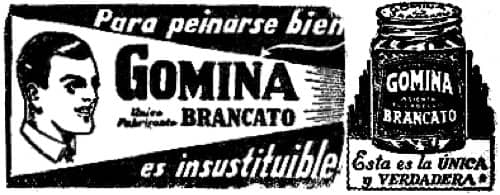
Above: Gomina, Argentina.
In 1933, Salomon switched employers becoming a salesman for Charles of the Ritz (Rhodes, 1974, p. 10) . This meant that he had a working knowledge of the company when he became its president in 1936. Undoubtedly, he called on advice from his uncle and from individuals like Otto Cohen [1888-1979] who had been a vice-president of Charles of the Ritz since 1927. Levy apparently bequeathed his ownership of the company to his nephew as, when Charles of the Ritz went public in 1961, Richard Salomon was listed as its sole owner.
New management
Between 1936 and December, 1941, when America entered into the Second World War, a number of changes were made. In 1938, a new trademark was introduced. Initially it was used in conjunction with the previous design developed by Gustav Boerge Jensen [1898-1954] but the older design was depreciated over time. The use of Ritz in product names also declined but did not vanish altogether.

Above: New Charles of the Ritz trademark.
A second development concerned advertising. In 1928, Charles of the Ritz had introduced its extended cosmetics line with a large advertising campaign. After that, direct advertising of the company’s cosmetics declined, switching mainly to cooperative advertising with the department and drug stores that sold its products. Any direct advertising placed by Charles of the Ritz usually promoted its hairdressing services rather than its cosmetics.
After 1936, there was a gradual increase in the amount of advertising the company devoted to cosmetics and the beauty treatments offered at Charles of the Ritz salons. The quality of the advertisements also improved, becoming more sophisticated and glamorous, with Charles of the Ritz Individually Blended Face Powders and Rejuvenescence (Revenescence) cosmetics most commonly featured.
Rejuvenescence/Revenescence
In 1938, Charles of the Ritz was issued with a cease and desist order from the Federal Trade Commission (FTC) regarding claims made by Charles of the Ritz for some of its products. Other American cosmetic companies were targeted with similar notices due to the provisions of the 1938 U.S. Food, Drugs and Cosmetics Act (FD&CA).
Said representations and claims are untrue in that said “Eye Lotion Ritz” does not strengthen the nerves, relieve eye strain, but is merely an eye wash which can in no way influence the delicate nerves of the eye; said “Scalp Food Ritz” does not promote the growth of hair, and cannot act as a scalp food when applied externally; said “Eye Cream Ritz” does not nourish the tissues, banish lines and prevent crow’s feet, in that it consists chiefly of petrolatum or vaseline which has no nourishing or wrinkle preventive quality; said “Rejuvenescence Cream Ritz” does not supply the skin with any youth giving element, nor does it penetrate the skin or revivify the tissues or give to the skin new life and vitality; and said “Eye lash Grower Ritz” contains no ingredient that makes it an eye lash grower, or which promotes the growth of the eyelashes, except some yellow mercuric oxide, which has a stimulating effect only when the follicles of the hair have not died or been destroyed.
(Federal Trade Commission decisions, 1936, p. 755)
The FTC considered the name Rejuvenescence to be misleading and Charles of the Ritz was forced to rebrand its Rejuvenescence cosmetics as Revenescence to avoid ongoing legal action.
Revenescence Cream: “If you want your skin to have that wonderfully fresh, dewy look, use this cream under your make-up in the daytime! Use it again at night, when you are relaxed. It is active in helping your skin to a clear radiance.”
Growth
In 1939, Charles of the Ritz bought the Doraldina Company. There is no obvious reason for this that I can see but both companies offered an individual face powder blending service and the Doraldina powder blending service seems to have been discontinued after 1939. The new owners maintained the brand and continued to develop the range which was positioned at a lower price point than Charles of the Ritz.
See also: Charles of the Ritz Powder Bars
Also in 1939, Charles of the Ritz formed Charles of the Ritz Distributors Ltd. (London), based at 33 Bruton Street, London. This was done to help the company avoid the rising import duties imposed by the British Government during the Great Depression. Charles of the Ritz also opened a London salon at 33 Bruton Street in Mayfair.
Also see: Beauty in the Modern Mode (c.1939)
Salon treatments
Hairdressing, particularly permanent waving, continued to be the mainstay of Charles of the Ritz salons but there were also treatment rooms where therapists could conduct ‘Tonic Touch’ facials, body treatments such as massage, as well as manicures and pedicures.
When your face feels weary, and your spirits droop, find quick refreshment in a “Tonic Touch” Facial. Forget your problems—surrender to the comfort of a charming Charles of the Ritz Treatment Room— and let skilled hands set your face atingling with new vitality.
(Charles of the Ritz advertisement, 1940)
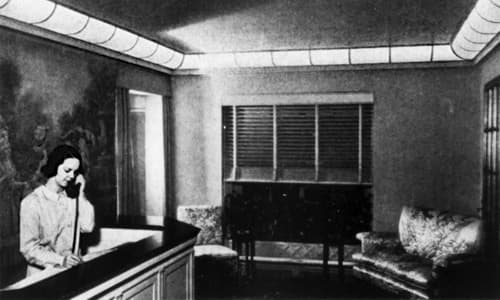
Above: 1938 Foyer of the modernised Charles of the Ritz salon in the Ritz Carlton Hotel.
Some salons also offered figure-control, Dewar Method treatments that used electrical impulses to induce muscle contration.
The most satisfactory modern miracle you’ve ever encountered—a remarkable device that does your exercising for you. No more flushed faces, tired muscles, tousled hair. All YOU do is relax in a pleasant treatment room while gentle electrical impulses put your muscles to work ridding the figure of surplus flesh.
(Charles of the Ritz advertisement, 1940)
Products
In 1936, Charles of the Ritz introduced two new products, Polar Cream Ritz and Throat Firming Cream. Polar Cream Ritz was designed to protect the skin from the drying effects of cold weather but it could also serve as a foundation.
Polar Cream Ritz: “[E]xtra rich mixture to combat drying and chapping. Use it over night, or any time during the day when you have half an hour to let it soak in.”
The Throat Firming Cream contained ‘rich oils and bracing agents’ with camphor as the possible bracing agent. The throat and neck were first cleansed with a cleansing cream, then the throat cream was stroked into the neck with gentle movements. It was left on for 15 minutes then the surplus was removed with tissues.
Throat Firming Cream: “[W]ill repair the ravages of time and weather and keep your neck firm, smooth, youthful.”
Other new products added before American entered the Second World War in December 1941 included: Velvet Glove Hand Lotion, and Cooling Masque (1938), the Moss Rose line of beauty and bath products, Smoothtan Oil and Cream, and Complexion Veil (1940).
Moss Rose was only one of a number of lines based on a fragrance that Charles of the Ritz introduced during this time. However, as far as I know, it was the only one used to name a shade of lipstick.
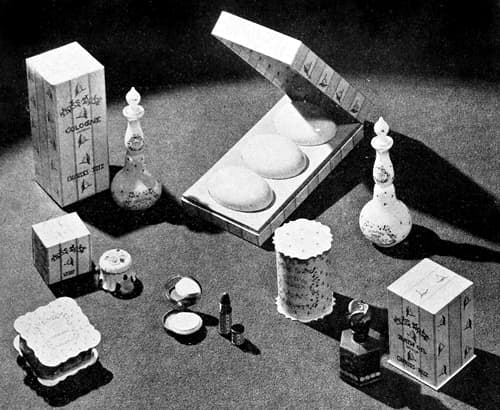
Above: 1941 Charles of the Ritz Moss Rose beauty and bath range.
Velvet Glove Hand Lotion: “A rich, penetrating,
elegant-smelling cream that should be smoothed into the hands as often as needed, working from the tips of the fingers toward the wrists.”
Cooling Masque: “Refreshing as a sea breeze—effective as sunshine and sea air—swiftly, simply brings new quality to your skin. When swimming or shopping melt make-up from your face its texture will be revealed smooth . . . clear.”

Above: 1940 Charles of the Ritz Smoothtan in oil for sun-tanners and creamy liquid for fair skins.
Smoothtan: “The sunburn preventive comes in both cream and oil form, in a generous size, easy-to-pour bottle. For white and sensitive-skinned bodies, use the cream generously to prevent of the burning (by the way, it’s a grand powder base for daytime summer use). You who want to tan without burning, use the oil.”
Complexion Veil: “A new cream powder base to be used on all types of skin to give a smooth, velvety finish and minimize the appearance of freckles, blemishes and unattractive enlarged pores.” Shades: Beige, Buff, Amber Rose, and Rose Rachel.
Skin-care
The Charles of the Ritz skin-care routines of the early 1940s showed some variation from the 1930s but the changes were not major. All toned with Skin Freshener – the replacement for Skin Tonic Ritz – except for oily skin where an astringent was still recommended. The different skin types still had their own individual cleansers and skin creams but most were renamed with clearer more meaningful titles. As with Revenescence Cream, some of the renaming appears to have been done to avoid problems with the FTC. Skin and Tissue Builder Ritz, for example, was renamed simply as Skin Cream while Throat Firming Cream looks to have been renamed as Throat Cream Plus.
Normal Skin
Cleanser: Normal Skin Cleanser
Day Cream: Skin Bloom
Night Cream: Skin Cream
Sensitive Skin
Cleanser: Sensitive Skin Cleanser
Day Cream: Skin Cream
Night Cream: Skin Cream
Dry Skin
Cleanser: Dry Skin Cleanser
Day Cream: Revenescence Cream
Night Cream: Velvet Texture Cream or Super Rich Cream
Oily Skin
Cleanser: Oily Skin Cleanser
Day Cream: Make-up Lotion
Night Cream: Requisite Cream
For problem skins with blackheads, enlarged pores, skin blemishes and superficial acne, the company now suggested cleansing with a soap recommended by a physician before using a Charles of the Ritz cleanser followed by a Special or Medicated Cream or Lotion.
Problem Skin with blackheads and enlarged pores
Cleanser: Physician recommended soap followed by cleanser appropriate for the skin type
Day Cream: Special Lotion
Night Cream: Special Cream
Extra treatment: Facial Glow Masque over cleansing cream
Problem Skin with blemishes and superficial acne
Cleanser: Physician recommended soap or Oily Skin Cleanser when removing make-up
Day Cream: Medicated Lotion
Night Cream: Medicated Cream or Medicated Lotion
Special Lotion and Special Cream appear to have been replacements for Pore Wash and Pore Paste and were used as a blackhead treatment. Medicated Cream and Medicated Lotion similarly replaced the older Acne Cream and Acne Lotion and were used on pimples. In both cases it is hard to know if these were reformulations or the products were just renamed. The medicinal agent used in the Medicated Cream and Lotion appears to have been phenol.
Special Lotion: “[A] liquid cleanser to refresh and aid in clearing the surface of the skin of impurities.”
Special Cream: “[A] most efficacious night cream which softens the skin and thus helps it improve its appearance.”
Medicated Cream: “[F]or aid in soothing blemished skin.”
Medicated Lotion: “[F]or soothing, and to be used as a make-up base for all problem skins.”
Also see: Personalized Beauty Care (c.1941)
Make-up
Little changed in the Charles of the Ritz make-up range in the period between 1936 and the 1941. The most important new make-up line was Complexion Veil (1940), an opaque cream that was used under powder to minimise the appearance of skin blemishes such as freckles and enlarged pores.
Complexion Veil: “A flattering, velvety foundation which gives a smooth textured appearance to the complexion. Veils minor blemishes and helps conceal freckles.” Shades: French Buff, Rose Beige, and Suntan, with Camellia and Amber Rose added by 1944.
A number of new matched shades of lipstick and rouge were also introduced in this period. Those that I know of are: Sungold, and Sunrose (1936); Redwing, and Cinnamon (1937); Petunia, and Grapewine (1938); Flare Red, So Red Rose, Bonfire, and Hibiscus (1939); Parisienne, Moss Rose, and Pink Geranium (1940); and Fandango-Day, Fandango-Night, Raspberry Ice, and Red Mitten (1941). Surprisingly, very few of these shades appear to have been produced in matching Charles of the Ritz nail polishes.
Wartime
Between 1942 and 1946 Salomon served in the U.S. Army Signal Corps. Starting as an enlisted man, he rose to the rank of First Lieutenant and earned a bronze star.
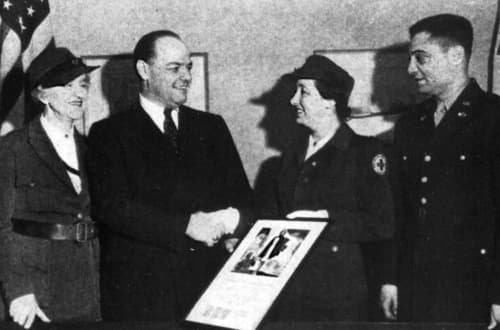
Above: 1943 Rose N. Braunstein presenting an American Red Cross Award to Robert E. Curran who took over the presidency of Charles of the Ritz while Salomon was on active duty. Aura Woodin (left) and Lieutenant Richard Salomon (right) are also present.
Despite the restrictions imposed on cosmetics during the hostilities, some new products were introduced by Charles of the Ritz during the war including Revenescence Lotion (1942), a liquid version of Revenescence Cream.
Revenescence Lotion: “For women whose skin becomes irritated by the massage of applying a cream and also for hot weather. Can also be used in the daytime as a powder base or overnight for those who prefer a non-greasy product.”
Like many other companies, Charles of the Ritz developed a stocking substitute simply called Leg Make-up.

Above: 1943 Charles of the Ritz Leg Make-up in Mirage and Gossamer shades.
See also: Cosmetic Stockings
The company also added a few new shades of lipstick and rouge including Camellia, and Red Pencil (1942); Romance Rose, and Flaming Fuchsia (1943); and Talisman (1944).
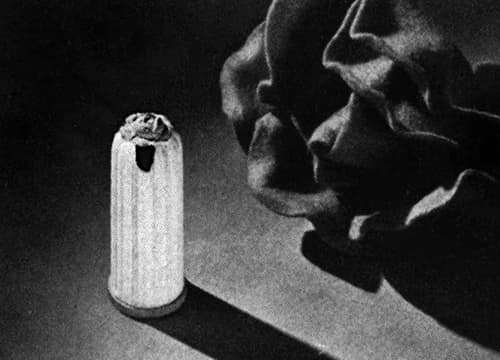
Above: 1943 Moss Rose Lipstick. Like many lipsticks cases produced during the war it was made from plastic not metal.
Timeline
| 1936 | Charles of the Ritz to Benjamin E. Levy. New Products: Polar Cream Ritz; and Throat Firming Cream. |
| 1938 | Ritz-Carlton salon in New York refurbished Charles of the Ritz logo updated. New Products: Velvet Glove Hand Lotion; and Cooling Masque. |
| 1939 | Doraldina, Inc. bought. Charles of the Ritz Distributors Ltd., London created. |
| 1940 | New Products: Complexion Veil; Smoothtan Oil and Cream; and the Moss Ross line of beauty and bath preparations. |
| 1941 | New Products: Raspberry Ice Cologne, Dusting Powder, and Foam Bath. |
| 1942 | New Products: Revenescence Lotion. |
Continue onto: Charles of the Ritz (post 1945)
First Posted: 21st March 2017
Last Update: 20th July 2022
Sources
Charles of the Ritz. (c.1939). Beauty in the modern mode [Booklet]. London: Author.
Charles of the Ritz. (c.1941). Personalized beauty care.[Pamplets]. New York: Author.
FBI Silvermaster file. (1946). Retrieved September 6, 2016 from https://archive.org/details/FBISilvermasterFile
Federal Trade Commission decisions: Findings,orders and stipulations, (Vol 23). (1936). Washington: U.S. Government Printing Office.
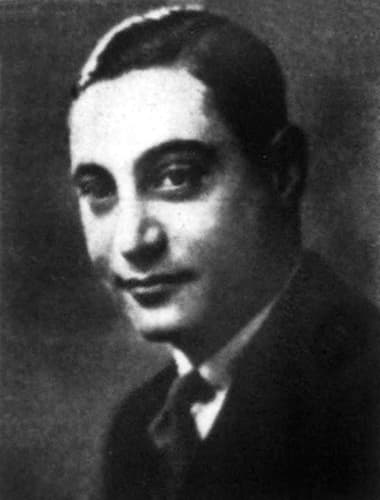
Richard Bernard Salomon [1912-1994].
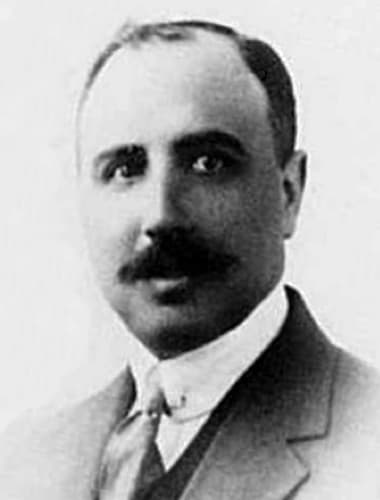
Benjamin Edward Levy [1878-1952]. This photograph was taken in 1919. He married Regine Salomon [1883-1952] in 1907.
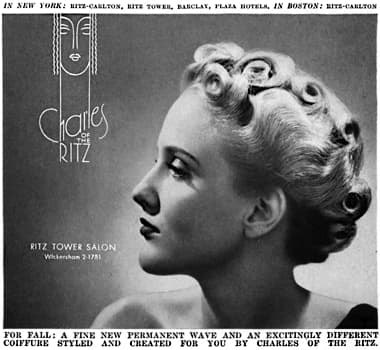
1937 Charles of the Ritz Permanent Wave.
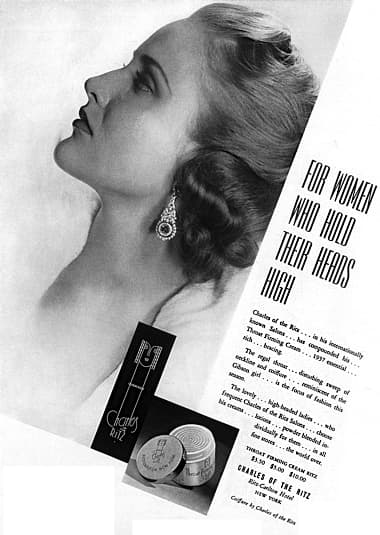
1937 Charles of the Ritz Throat Firming Cream.
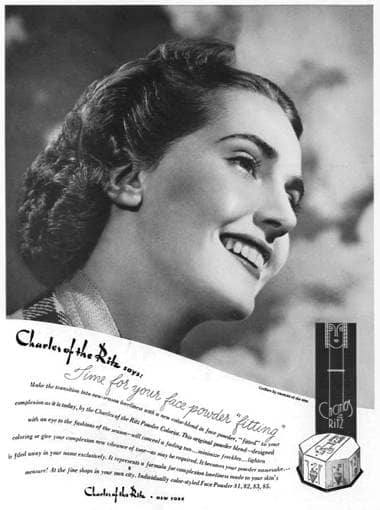
1938 Charles of the Ritz Powder.
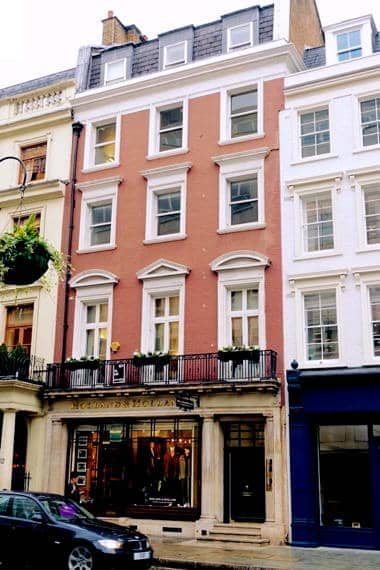
Modern day 33 Bruton Street, Mayfair, the site of Charles of the Ritz Distributors Ltd. (London) and the Charles of the Ritz London salon.
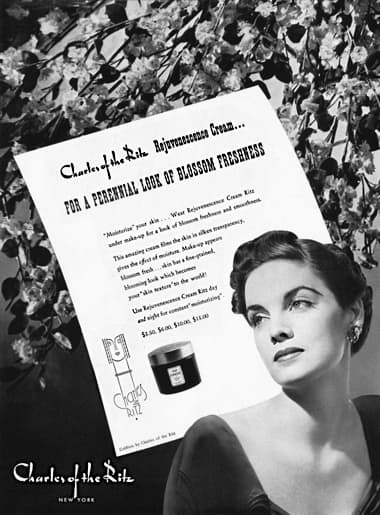
1939 Charles of the Ritz Rejuvenescence Cream. The company was forced to change the product name to Revenescence by the FTC.
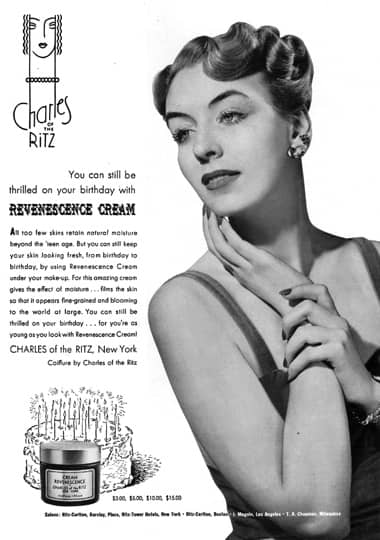
1940 Charles of the Ritz Revenescence Cream.
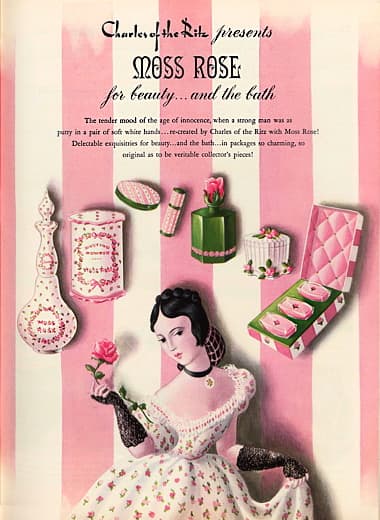
1940 Charles of the Ritz Moss Rose.
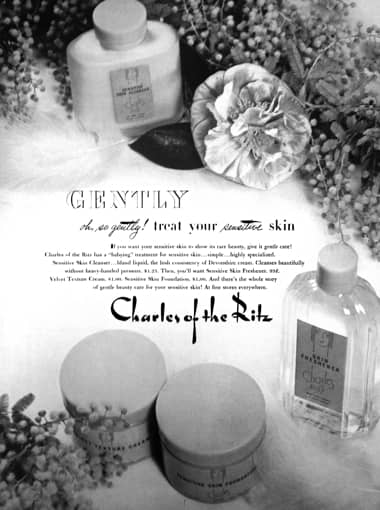
1941 Charles of the Ritz Sensitive Skin Treatment.
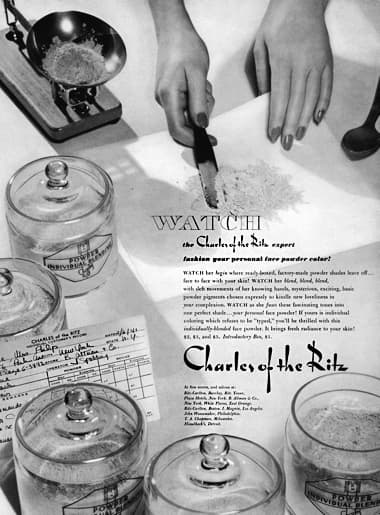
1941 Charles of the Ritz powder bending.
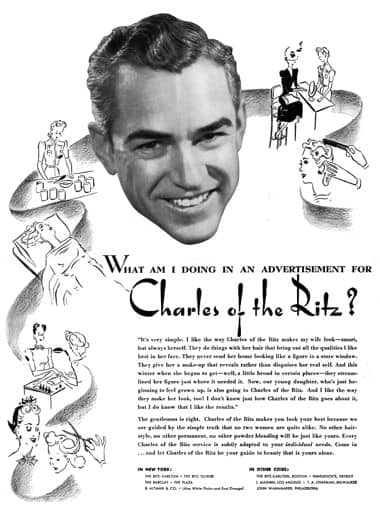
1941 Charles of the Ritz beauty treatments.
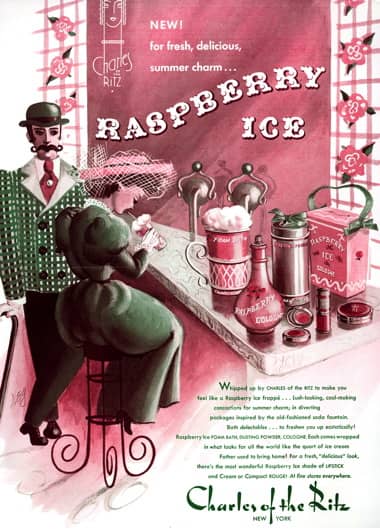
1941 Charles of the Ritz Raspberry Ice Cologne, Dusting Powder and Foam Bath with Raspberry Ice shade of lipstick and cream or compact rouge.
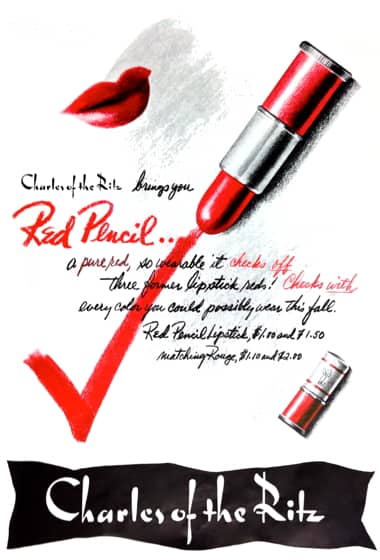
1942 Charles of the Ritz Red Pencil.
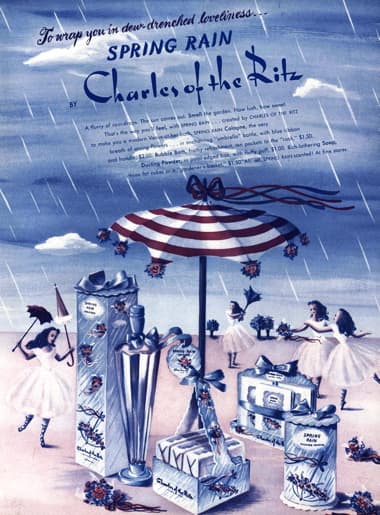
1942 Charles of the Ritz Spring Rain.
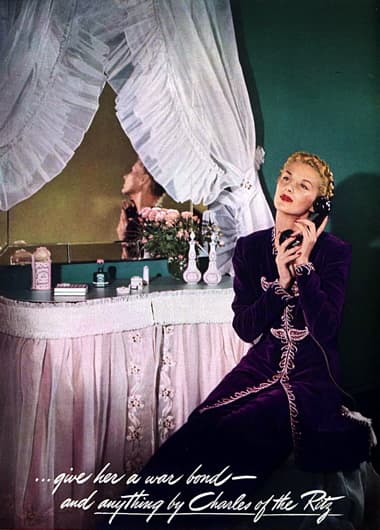
1943 Charles of the Ritz.
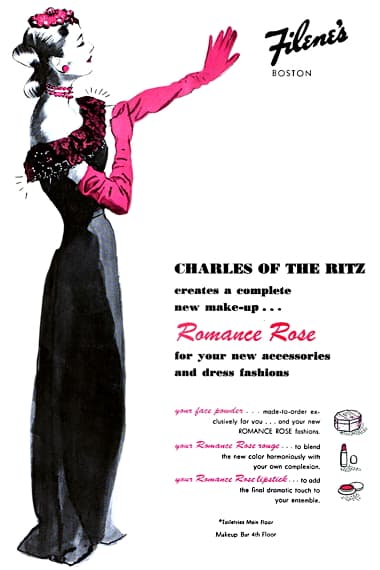
1943 Charles of the Ritz Romance Rose.
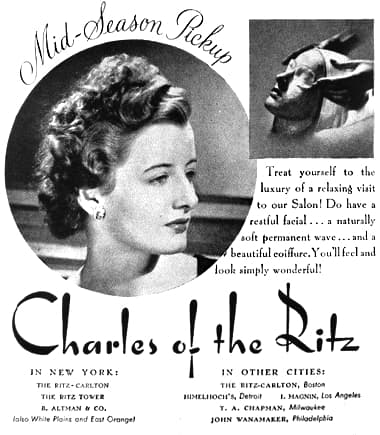
1944 Charles of the Ritz Mid-Season Pickup – hair style and facial.
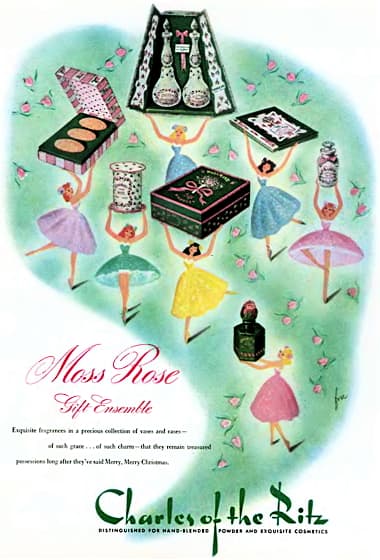
1944 Charles of the Ritz Moss Rose gift ensembles. Moss Rose beauty and bath preparations were first introduced in 1940.
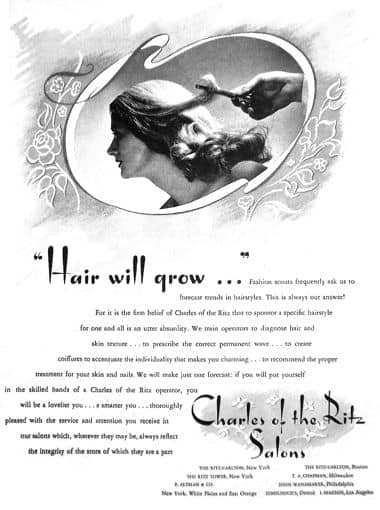
1944 Charles of the Ritz salons.

1945 Charles of the Ritz Feather Touch Sensitive Skin Cleanser. Charles of the Ritz trademarked ‘Feather Touch’ in 1942.
